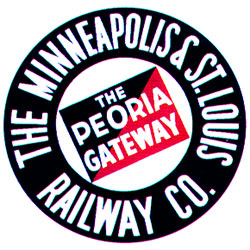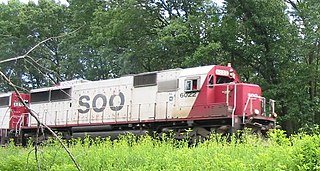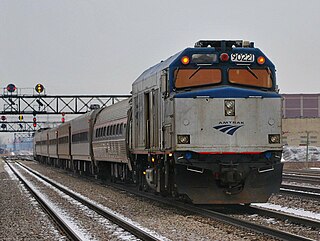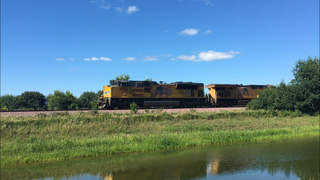
Saint Paul Union Depot is a historic railroad station and intermodal transit hub in the Lowertown neighborhood of the city of Saint Paul, Minnesota, United States. It serves light rail, intercity rail, intercity bus, and local bus services.

The 400 was a named passenger train operated by the Chicago and North Western Railway between Chicago and Saint Paul, with a final stop in Minneapolis. The train took its name from the schedule of 400 miles between the cities in 400 minutes, and was also a nod to "The Four Hundred Club", a term coined by Ward McAllister to refer to the social elite of New York City in the late 19th century. It was an express train with limited stops between Chicago and the Twin Cities. The "400" ran from 1935 to 1963 on the Chicago to Twin Cities route. The C&NW later named their other passenger trains using the number "400".

The Chicago, St. Paul, Minneapolis and Omaha Railway or Omaha Road was a railroad in the U.S. states of Nebraska, Iowa, Minnesota, Wisconsin and South Dakota. It was incorporated in 1880 as a consolidation of the Chicago, St. Paul and Minneapolis Railway and the North Wisconsin Railway. The Chicago and North Western Railway (C&NW) gained control in 1882. The C&NW leased the Omaha Road in 1957 and merged the company into itself in 1972. Portions of the C. St. P. M. and O. are part of the Union Pacific Railroad network. This includes main lines from Wyeville, Wisconsin, to St. Paul, Minnesota, and St. Paul to Sioux City, Iowa.

The Minneapolis and St. Louis Railway (M&StL) was an American Class I railroad that built and operated lines radiating south and west from Minneapolis, Minnesota for 90 years from 1870 to 1960. The railway never reached St. Louis but its North Star Limited passenger train ran to that city via the Wabash Railroad.

The Twin Cities Zephyr was a streamlined passenger train on the Chicago, Burlington and Quincy Railroad (CB&Q), running between Chicago and the Twin Cities of Minneapolis and Saint Paul in Minnesota. It was the second Zephyr service introduced by CB&Q after the record-setting Denver–Chicago "dawn to dusk dash" of the Pioneer Zephyr trainset.
There are several passenger rail projects being discussed in Minnesota. There is one existing commuter rail service in the state, the Northstar Line, and one existing long-distance intercity rail service, the Empire Builder. Future projects include a mixture of short-distance commuter rail and medium-distance regional rail lines which would run from the Twin Cities outward to neighboring states and perhaps Canada.

The Iowa Northern Railway is a Class III shortline railroad operating in the U.S. state of Iowa.

The Minneapolis Great Northern Depot, also known as Great Northern Station, was a passenger railroad station which served Minneapolis, Minnesota, USA. It was built in 1913 and demolished in 1978. It was located on Hennepin Avenue next to the Hennepin Avenue Bridge and across the street from the main Minneapolis Post Office.

The Twin Cities Hiawatha, often just Hiawatha, was a named passenger train operated by the Chicago, Milwaukee, St. Paul and Pacific Railroad, and traveled from Chicago to the Twin Cities. The original train takes its name from the epic poem The Song of Hiawatha by Henry Wadsworth Longfellow. There are a number of Hiawatha-themed names within the city of Minneapolis, the terminus of the original train. The first Hiawatha ran in 1935; in 1939 the Milwaukee Road introduced a second daily trip between Chicago and Minneapolis. The two trains were known as the Morning Hiawatha and Afternoon Hiawatha, or sometimes the AM Twin Cities Hiawatha and PM Twin Cities Hiawatha. The Milwaukee Road discontinued the Afternoon Hiawatha in 1970 while the Morning Hiawatha continued running until the formation of Amtrak in 1971.
The Sioux City and Pacific Railroad was a railroad in the U.S. states of Iowa and Nebraska. Built as a connection from Sioux City, Iowa to the Union Pacific Railroad at Fremont, Nebraska, it became part of the Chicago and North Western Railway system in the 1880s, and is now a main line of the Union Pacific (UP). The east–west portion from Fremont to Missouri Valley, Iowa, is the Blair Subdivision, carrying mainly westbound UP trains, and the line from California Junction, Iowa north to Sioux City is the Sioux City Subdivision.
Org is an unincorporated community in Nobles County, Minnesota, United States.

The River Subdivision or River Sub is a railway line along the Mississippi River that runs approximately 124 miles (200 km) from Saint Paul, Minnesota south to La Crescent. U.S. Highway 61 closely parallels the route between La Crescent and Red Wing. The line is operated by the Canadian Pacific Railway through its primary United States subsidiary, the Soo Line Railroad. BNSF Railway operates a complementary St. Croix Subdivision which traces the eastern side of the river in Minnesota and Wisconsin. The two routes share some track between Saint Paul and St. Croix Junction, near Hastings.

The Tomah Subdivision or Tomah Sub is a railway line that runs about 103 miles (166 km) from La Crosse, WI in the west to Portage, WI in the east.
The Canadian Pacific Railway's Merriam Park Subdivision or Merriam Park Sub, also known as the Short Line, is a railway line in Saint Paul, Minnesota. It is run by the Soo Line Railroad, a U.S. in-name-only division of CP. It runs from the Saint Paul Yard, also known as the Pigs Eye Yard, westward to the Short Line Bridge over the Mississippi River, where rails continue as part of the Minnesota Commercial Railway. It was named for John L. Merriam, a Minnesota banker and politician. Completed by the Chicago, Milwaukee and St. Paul Railroad in 1880, it shortened the route Milwaukee Road trains took between downtown Saint Paul and downtown Minneapolis. Previous trains would exit Saint Paul and follow the Mississippi River southwest until crossing at Fort Snelling, where they would follow the path of today's Hiawatha Avenue and the Metro Blue Line toward the Milwaukee Road Depot. Originally built as an interurban route, it was eventually converted for heavy rail traffic because the Twin City Rapid Transit streetcar system had taken over the local transit market.

The Watertown Subdivision or Watertown Sub is a 92.7-mile (149.2 km) railway line in Wisconsin operated by the Canadian Pacific Railway (CP) through its primary United States subsidiary, the Soo Line Railroad. It meets CP's Tomah Subdivision in the west in Portage and runs to Milwaukee in the east where it meets the C&M Subdivision. The Watertown Subdivision had previously been operated by the Chicago, Milwaukee, St. Paul and Pacific Railroad, though the Soo Line Railroad took it over when the Milwaukee Road folded. Canadian Pacific gained ownership via taking over the Soo Line.

The Chicago and Milwaukee Subdivision is a 85.5-mile (137.6 km) railway line running between Chicago, Illinois and Milwaukee, Wisconsin. It is mostly dispatched by the Canadian Pacific Railway from a CP Rail facility in Minneapolis. From Pacific Junction to Chicago Union Station, it is dispatched by Metra's Consolidated Control Facility. The C&M Subdivision is the primary of CP's two northern routes from Chicago. The Union Pacific Railroad operates its Milwaukee Subdivision, a former Chicago & Northwestern Railway line, parallel to the C&M.
The Winona and St. Peter Railroad was a railroad in the Midwestern United States. It was founded in 1861 in Winona, Minnesota. The first 11 miles (18 km) from Winona to Stockton, Minnesota, were completed by the end of 1862, making the it the second operational railroad in Minnesota, after the St. Paul and Pacific Line from Saint Paul to St. Anthony Falls.

Rapid City, Pierre and Eastern Railroad is a Class II railroad operating across South Dakota and southern Minnesota in the northern plains of the United States. Portions of the railroad also extend into Wyoming and Nebraska. It is owned and operated by Genesee & Wyoming. The primary commodities shipped are grain, clay, and cement. Operations began on June 1, 2014.
The Worthington Subdivision or Worthington Sub is a railway line operated by Union Pacific Railroad. It runs generally southwest-northeast and begins at a siding in St. James Township, Minnesota, where the Mankato Subdivision ends, and it continues to Sioux City, Iowa. The line has yard facilities in Worthington and Sioux City, as well as a small yard north of Worthington in Hersey and Lorain townships called Elk Creek. The line passes through many small towns and villages with grain elevators along its route, and it is the origin of numerous grain unit trains.

The Altoona Subdivision or Altoona Sub is a 90.7-mile (146.0 km) railway line owned and operated by the Union Pacific Railroad in the states of Minnesota and Wisconsin. The line originates in Saint Paul, Minnesota, crosses the St. Croix River on the Hudson Bridge into Hudson, Wisconsin, and eventually terminates in Altoona, Wisconsin where it connects to the Wyeville Subdivision. This subdivision is formerly a Chicago and North Western Railway (C&NW) mainline, on which the Twin Cities 400 operated in the mid 1900s.













